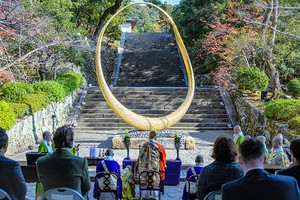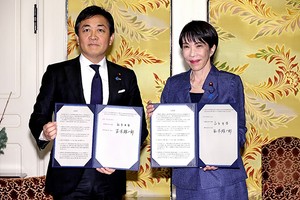By SHIMPACHI YOSHIDA/ Senior Staff Writer
March 6, 2023 at 18:50 JST
 Staff and participants ride electric kick scooters during a safety training session in Tokyo’s Chiyoda Ward in December 2021. (Asahi Shimbun file photo)
Staff and participants ride electric kick scooters during a safety training session in Tokyo’s Chiyoda Ward in December 2021. (Asahi Shimbun file photo)
The National Police Agency said there have been 74 traffic accidents involving electric kick scooters across Japan over the past three years, and about two-thirds were crashes with other vehicles.
One person died and 76 others were injured in the accidents, according to police data compiled from around the country.
Cars, motorcycles and bicycles caused 65 percent of the accidents with the scooters, according to the data.
The data was released just ahead of changes to road laws this summer that will relax the rules for riding electric scooters.
Revisions to the Road Traffic Law that come into effect on July 1 will remove the requirement for having a license to drive an e-scooter, which will legally be considered “equivalent to a bicycle.”
According to the NPA, five people were injured in four accidents in 2020 where an electric scooter driver was listed as the first or second party involved. First parties are most often the ones found at fault for causing the accident.
Thirty people were injured in 29 such cases in 2021, while one person died and 41 others were injured in 41 cases in 2022.
A 52-year-old man died after he fell from the electric scooter he was driving in a building’s parking lot in Tokyo’s Chuo Ward in September 2022. He was drunk at the time, police said.
Of the 74 accidents involving electric scooters, 31 were collisions with cars, 14 with bicycles and three with motorcycles. Combined, 65 percent of the accidents involved crashes with other vehicles.
There were 18 cases of crashes involving only a scooter, accounting for 24 percent, while there were eight cases of accidents involving pedestrians, or 11 percent of the total.
It is not clear whether the people who were injured in these accidents were the drivers of the electric scooters, the NPA said.
Traffic accidents involving electric scooters occurred in 14 of 47 prefectures, and mostly took place in big cities.
Tokyo had the largest number of cases at 49, followed by Osaka Prefecture at six, and Kanagawa Prefecture at five.
Saitama, Aichi and Hyogo prefectures each had two cases, while Ibaraki, Gunma, Chiba, Ishikawa, Tokushima, Fukuoka, Nagasaki and Okinawa prefectures had only one case each.
Police issued warnings or cracked down on traffic rule violations in 3,089 instances from September 2021 to December 2022.
Traffic rule violations, such as driving on sidewalks where scooters are not allowed, accounted for 1,345, or 43.5 percent, of those cases. That was the largest category.
It was followed by 447 cases of poor maintenance of electric scooters, 384 cases of ignoring traffic signals, 286 cases of driving without a license and 137 cases of failing to stop.
There were also 69 cases of drunken driving.
The Road Traffic Law defines electric scooters as “motorized bicycles,” which means riders must have a driver’s license. The maximum legal speed is 30 kph.
But the rules will be changed following requests from scooter-sharing businesses.
The government started a trial program in October 2020, where e-scooters were categorized as “special small motor vehicles,” with a maximum speed limit of 15 kph, to see how communities would benefit from easy-to-use scooter-share systems.
Under the revised law, no license will be required for models with a top speed under 20 kph. There are no penalties for being found not wearing a helmet, which is only recommended under the law.
But people under the age of 16 cannot ride these scooters.
Electric scooters can ride on the left side of car lanes, as well as in bicycle lanes. Riders who keep their speed under 6 kph can ride on sidewalks.




















A peek through the music industry’s curtain at the producers who harnessed social media to help their idols go global.
A series based on diplomatic documents declassified by Japan’s Foreign Ministry
Here is a collection of first-hand accounts by “hibakusha” atomic bomb survivors.
Cooking experts, chefs and others involved in the field of food introduce their special recipes intertwined with their paths in life.
A series about Japanese-Americans and their memories of World War II